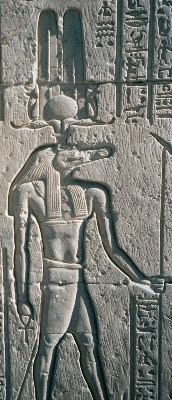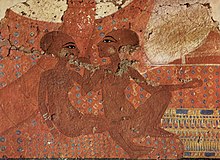Art of ancient Egypt: Difference between revisions
ClueBot NG (talk | contribs) m Reverting possible vandalism by 98.229.51.237 to version by The Master of Mayhem. False positive? Report it. Thanks, ClueBot NG. (404131) (Bot) |
m →External links: added external link |
||
| Line 91: | Line 91: | ||
*[http://revistaorientalia.blogspot.com/2007/07/segn-investigadores-el-arte-mas-antiguo.html Ancient Egyptian art discovered in Qurta] |
*[http://revistaorientalia.blogspot.com/2007/07/segn-investigadores-el-arte-mas-antiguo.html Ancient Egyptian art discovered in Qurta] |
||
{{Ancient Egypt topics}} |
{{Ancient Egypt topics}} |
||
*[http://www.ancientegyptonline.co.uk/colour.html the meaning of colour in ancient Egyptian art] |
|||
[[Category:Art of ancient Egypt| ]] |
[[Category:Art of ancient Egypt| ]] |
||
Revision as of 10:51, 18 May 2011
| Ancient art history |
|---|
| Middle East |
| Asia |
| European prehistory |
| Classical art |
Ancient Egyptian art is the painting, sculpture, architecture and other arts produced by the civilization in the lower Nile Valley from 5000 BC to 300 AD. Ancient Egyptian art reached a high level in painting and sculpture, and was both highly stylized and symbolic. Much of the surviving art comes from tombs and monuments and thus there is an emphasis on life after death and the preservation of knowledge of the past.
In a more narrow sense, Ancient Egyptian art refers to the canonical 2nd and 3rd Dynasty art developed in Egypt from 3000 BC and used until the 3rd century. Most elements of Egyptian art remained remarkably stable over that 3,000 year period with relatively little outside influence. The quality of observation and execution started at a high level and remained near that level throughout the period.
Periods

- Predynastic (4210 BC–2680 BC)
- Old Kingdom (2680 BC–2258 BC)
- Middle Kingdom (2258 BC–1786 BC)
- New Kingdom (1786 BC–1085 BC)
- Amarna Period (1085 BC–1055 BC)
- Third Intermediate Period, First Persian Period, Late Period of ancient Egypt
Second Persian Period and the start of Greek Egypt (1055 BC–287 BC)
Symbolism
Symbolism also played an important role in establishing a sense of order. Symbolism, ranging from the pharaoh's regalia (symbolizing his power to maintain order) to the individual symbols of Egyptian gods and goddesses, is omnipresent in Egyptian art. Animals were usually also highly symbolic figures in Egyptian art. Colors were more expressive rather than natural: red skin implied vigorous tanned youth, whereas yellow skin was used for women or middle-aged men who worked indoors; blue or gold indicated divinity because of its unnatural appearance and association with precious materials; the use of black for royal figures expressed the fertility of the Nile from which Egypt was born. Stereotypes were employed to indicate the geographical origins of foreigners[1]
Art forms

Ancient Egyptian art forms are characterized by regularity and detailed depiction of gods, human beings and nature, and were intended to provide solace to the deceased in the afterlife. Artists endeavored to preserve everything from the present as clearly and permanently as possible. Ancient Egyptian art was created using mediums ranging from papyrus drawings to pictographs (hieroglyphics) and include funerary sculpture carved in relief and in the round from sandstone, quartz diorite and granite. Ancient Egyptian art displays an extraordinarily vivid representation of the Ancient Egyptian's socioeconomic status and belief systems. Egyptian art in all forms obeyed one law: the mode of representing Pharo's, gods, man, nature and the environment remained consistant for thousands of years. The most admired artists were those who replicated the stylized depictions of Egypts most venerated figures; humanity or divinity.
Architecture
Ancient Egyptian architects used sun-dried and kiln-baked bricks, fine sandstone, limestone and granite. Architects carefully planned all their work. The stones had to fit precisely together. Ramps were used to allow workmen to move up as the height of the construction grew. When the top of the structure was completed, the artists decorated from the top down, removing ramp sand as they went down. Exterior walls contained only a few small openings. Hieroglyphic and pictorial carvings in brilliant covers were abundantly used to decorate the structures, including many motifs, like the scarab, sacred beetle, the solar disk, and the vulture.
Papyrus

The word "paper" is derived from "papyrus", a plant which was cultivated in the Nile delta. Papyrus sheets were derived after processing the papyrus plant. Some rolls of papyrus discovered are up to 10 meters long but usually only up to 30 cm. wide. The technique for crafting papyrus was lost over time, but was rediscovered by an Egyptologist in the 1940s. Papyrus was used by ancient Egyptians for writing and painting. Papyrus is relatively fragile, and though used all over the classical world has only survived when buried in the very dry conditions of Egypt, and even then is often in poor condition.
Papyrus texts illustrate all dimensions of ancient Egyptian life and include literary, religious, historical and administrative documents. The pictorial script used in these texts ultimately provided the model for two most common alphabets in the world, the Roman and the Arabic.
Pottery


Ancient Egyptians used steatite (some varieties were called soapstone) and carved small pieces of vases, amulets, images of deities, of animals and several other objects. Ancient Egyptian artists also discovered the art of covering pottery with enamel. Covering by enamel was also applied to some stone works.
Different types of pottery items were deposited in tombs of the dead. Some such pottery items represented interior parts of the body, like the heart and the lungs, the liver and smaller intestines, which were removed before embalming. A large number of smaller objects in enamel pottery were also deposited with the dead. It was customary to craft on the walls of the tombs cones of pottery, about six to ten inches tall, on which were engraved or impressed legends relating to the dead occupants of the tombs. These cones usually contained the names of the deceased, their titles, offices which they held, and some expressions appropriate to funeral purposes.
Sculpture

The ancient art of Egyptian sculpture evolved to represent the ancient Egyptian gods, Pharaohs, and the kings and queens, in physical form. There were also large numbers of ka statues and block statues in private tombs, mostly in wood; few of these have survived. Whether there was real portraiture in Ancient Egypt or not is still debated. Massive statues were built to represent gods and pharoahs and their queens, usually for open areas in or outside temples. The very early colossal Great Sphinx of Giza was never repeated, but avenues lined with very large statues including sphinxes and other animals formed part of many temple complexes. The most sacred cult image of a god in a temple, usually held in the naos, was in the form of a relatively small boat or barque holding an image of the god, and apparently usually in precious metal - none have survived. There were also large numbers of small carved objects, from figures of the gods to toys and carved utensils. Alabaster was often used for expensive versions of these; painted wood was the most common material, and normal for the small models of animals, slaves and possessions placed in tombs to provide for the afterlife.
Very strict conventions were followed while crafting statues: male statues were darker than the female ones; in seated statues, hands were required to be placed on knees and specific rules governed appearance of every Egyptian god. For example, the sky god (Horus) was essentially to be represented with a falcon’s head, the god of funeral rites (Anubis) was to be always shown with a jackal’s head. Artistic works were ranked according to their compliance with these conventions, and the conventions were followed so strictly that, over three thousand years, the appearance of statues changed very little. These conventions were intended to convey the timeless and non-aging quality of the figure's ka.[2]
Hieroglyphs
Hieroglyphics are the ancient Egyptian writing system in which pictures and symbols stand for sounds and words. Jean-Francois Champollion first decoded hieroglyphics from Rosetta Stone, which was found in 1799. Hieroglyphics have more than 700 symbols.
Literature
Ancient Egyptian literature, most often written on papyrus, also contains elements of ancient Egyptian art, as the texts and connected pictures were recorded on papyrus or on wall paintings and so on. They date from the Old Kingdom to the Greco-Roman period.
The subject matter of such literature-related art forms include hymns to the gods, mythological and magical texts, mortuary texts. Other subject matters were biographical and historical texts, scientific premises, including mathematical and medical texts, wisdom texts dealing with instructive literature, fables and stories.
Paintings

All Egyptian reliefs were painted, and less prestigous works in tombs, temples and palaces were just painted on a flat surface. Stone surfaces were prepared by whitewash, or if rough, a layer of coarse mud plaster, with a smoother gesso layer above; some finer limestones could take paint directly. Pigments were mostly mineral, chosen to withstand strong sunlight without fading. The binding medium used in painting remains unclear: egg tempera and various gums and resins have been suggested. It is clear that true fresco, painted into a thin layer of wet plaster, was not used. Instead the paint was applied to dried plaster, in what is called "fresco a secco" in Italian. After painting a varnish or resin protective coating was usually applied, and many paintings with some exposure to the elements have survived remarkably well, although those on fully exposed walls rarely have.[3] Small objects including wooden statuettes were often painted using similar techniques.
Many ancient Egyptian paintings have survived due to Egypt's extremely dry climate. The paintings were often made with the intent of making a pleasant afterlife for the deceased. The themes included journey through the afterworld or protective deities introducing the deceased to the gods of the underworld (such as Osiris). Some tomb paintings show activities that the deceased were involved in when they were alive and wished to carry on doing for eternity.
In the New Kingdom and later, the Book of the Dead was buried with the entombed person. It was considered important for an introduction to the afterlife.
Egyptian paintings are painted in such a way to show a profile view and a side view of the animal or person. For example, the painting to the right shows the head from a profile view and the body from a frontal view. Their main colors were red, blue, black, gold, and green.
Evolution

The Ancient Egyptian art style known as Amarna art was a style of art that was adopted in the Amarna Period (i.e. during and just after the reign of Akhenaten in the late Eighteenth Dynasty), and is noticeably different from more conventional Egyptian art styles.
It is characterized by a sense of movement and activity in images, with figures having raised heads, many figures overlapping and many scenes busy and crowded. Also, the human body is portrayed differently in Amarna style artwork than Egyptian art on the whole. For instance, many depictions of Akhenaten's body give him distinctly feminine qualities, such as large hips, prominent breasts, and a larger stomach and thighs. This is a divergence from the earlier Egyptian art which shows men with perfectly chiseled bodies. Faces are still shown exclusively in profile. Not many buildings from this period have survived the ravages of later kings, partially as they were constructed out of standard size blocks, known as Talatat, which were very easy to remove and reuse. Temples in Amarna, following the trend, did not follow traditional Egyptian customs and were open, without ceilings, and had no closing doors.
In the generation after Akhenaten's death, artists reverted to their old styles. There were still traces of this period's style in later art.
See also
References
External links
- Ancient Egyptian Art - Aldokkan
- The Art of ancient Egypt
- Senusret Collection: A well-annotated introduction to the arts of Egypt
- Ancient Egyptian Art at the Cincinnati Art Museum
- Ancient Egyptian art discovered in Qurta

